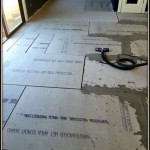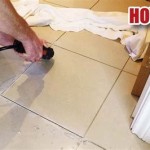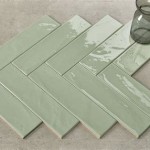How to Install Bathroom Floor Tile on Concrete
Installing bathroom floor tile over a concrete subfloor is a common and effective way to create a durable and aesthetically pleasing surface. Concrete provides a solid and stable base for tile, offering excellent support and resistance to moisture damage. However, a successful installation requires careful preparation, adherence to established techniques, and the use of appropriate materials. This article details the process of installing bathroom floor tile on concrete, outlining each step from initial assessment to final grouting.
Preparing the Concrete Subfloor
The foundation for any successful tile installation is a properly prepared subfloor. This is particularly crucial with concrete, as imperfections or contaminants can compromise the adhesion of the tile and lead to premature failure. The initial step involves a thorough inspection of the concrete surface.
Existing concrete floors often have cracks, unevenness, or remnants of previous flooring materials. These issues must be addressed before tile installation can begin. Cracks wider than 1/8 inch should be repaired with a concrete crack filler. This involves cleaning out the crack, applying the filler according to the manufacturer's instructions, and allowing it to cure completely. For larger or more extensive cracks, consulting a structural engineer or concrete specialist is advisable to determine the underlying cause and implement a long-term repair solution.
Unevenness in the concrete subfloor should be corrected using self-leveling compound. This material is poured onto the floor and allowed to spread, creating a perfectly level surface. The instructions provided by the self-leveling compound manufacturer must be followed meticulously, paying close attention to mixing ratios and curing times. Before applying the self-leveling compound, the floor should be primed to ensure proper adhesion.
Cleaning the concrete surface is a critical step in the preparation process. All dirt, dust, grease, oil, and other contaminants must be removed. A thorough scrubbing with a concrete cleaner and a stiff brush is recommended, followed by rinsing with clean water. For stubborn stains or residues, a more aggressive cleaning agent or mechanical abrasion may be necessary. The floor must be completely dry before proceeding to the next step.
After cleaning, the concrete subfloor should be tested for moisture content. Excessive moisture can interfere with the adhesion of the thin-set mortar and lead to tile failure. A concrete moisture meter can be used to measure the moisture levels accurately. If the moisture content exceeds the recommended limits specified by the thin-set mortar manufacturer, moisture remediation techniques may be required. These techniques can include the use of dehumidifiers, moisture barriers, or other specialized products.
Choosing the Right Materials
Selecting the appropriate materials is as important as proper subfloor preparation. The type of tile, thin-set mortar, grout, and sealant all contribute to the longevity and performance of the finished bathroom floor.
Bathroom floors are subjected to frequent moisture exposure, so tile designed for wet environments is essential. Porcelain tile is a popular choice due to its low water absorption rate, durability, and resistance to stains. Ceramic tile is another option, but it is generally less dense and more porous than porcelain, making it more susceptible to water damage. Natural stone tiles, such as granite or slate, can also be used, but they require proper sealing and maintenance to prevent staining and water penetration. The size and shape of the tile should be considered in relation to the size of the bathroom and the desired aesthetic.
Thin-set mortar is the adhesive that bonds the tile to the concrete subfloor. It is crucial to select a thin-set mortar that is specifically formulated for use with the chosen tile type and the concrete substrate. Modified thin-set mortars, which contain polymers to improve adhesion and flexibility, are generally recommended for bathroom floor installations. The thin-set mortar should be mixed according to the manufacturer's instructions, ensuring a consistent and lump-free consistency. The open time of the thin-set mortar, which is the amount of time it remains workable after mixing, should also be considered, as it can vary depending on the product and environmental conditions.
Grout fills the spaces between the tiles and creates a watertight seal. Cement-based grout is the most common type of grout used for bathroom floor tile installations. It is available in sanded and unsanded varieties. Sanded grout is typically used for grout joints wider than 1/8 inch, while unsanded grout is used for narrower joints. Epoxy grout is another option, but it is more expensive and requires specialized installation techniques. Epoxy grout is highly resistant to water, stains, and chemicals, making it a good choice for high-moisture environments. The color of the grout should be chosen to complement the tile and the overall bathroom design.
Sealer is applied to the grout lines to protect them from staining and water penetration. A penetrating sealer is recommended, as it penetrates the grout and creates a barrier against moisture. The sealer should be applied according to the manufacturer's instructions, ensuring that all grout lines are thoroughly coated. Regular reapplication of the sealer may be necessary to maintain its effectiveness.
Laying the Tile
The process of laying the tile requires careful planning and execution to ensure a professional and aesthetically pleasing result. Before beginning the installation, the layout of the tile should be planned to minimize cuts and create a balanced and symmetrical appearance. This involves measuring the room, determining the center point, and dry-laying the tile to visualize the final layout. Any necessary cuts should be planned in advance, and the appropriate cutting tools should be readily available.
Thin-set mortar should be applied to the concrete subfloor using a notched trowel. The size and shape of the trowel notches should be chosen according to the tile size and the thin-set mortar manufacturer's recommendations. The thin-set mortar should be applied in small sections, ensuring that it is evenly distributed and that the notches are maintained. The tile should be immediately pressed into the thin-set mortar with a slight twisting motion to ensure good contact and adhesion. Spacers should be used between the tiles to maintain consistent grout joint widths.
As the tile is laid, it should be checked for level and alignment. A level should be used to ensure that the tiles are flush with each other and that there are no lippage (uneven edges). A straight edge can be used to ensure that the tiles are aligned in straight lines. Any adjustments should be made immediately, before the thin-set mortar begins to set. Excess thin-set mortar should be removed from the tile surface with a damp sponge.
Cutting tiles is often necessary to fit around fixtures, corners, and edges. A tile cutter or wet saw can be used to cut tiles accurately. A tile cutter is suitable for straight cuts, while a wet saw is better for curved or intricate cuts. Safety glasses should be worn when cutting tile to protect the eyes from debris. The cut edges of the tile should be smoothed with a rubbing stone to remove any sharp edges.
After all the tile has been laid, it should be allowed to cure for the amount of time specified by the thin-set mortar manufacturer. This typically ranges from 24 to 72 hours. During this time, the tile should not be disturbed. Walking on the tile or applying weight to it can disrupt the bond between the tile and the thin-set mortar and lead to premature failure.
Once the thin-set mortar has cured, the spacers should be removed. A utility knife or a grout removal tool can be used to remove the spacers without damaging the tile or the thin-set mortar. The grout joints should be cleaned of any debris or excess thin-set mortar before grouting.
Grout should be mixed according to the manufacturer's instructions, ensuring a consistent and lump-free consistency. The grout should be applied to the tile surface using a grout float. The grout float should be held at a 45-degree angle and moved diagonally across the grout joints, forcing the grout into the spaces between the tiles. Excess grout should be removed from the tile surface with the grout float.
After the grout has been applied, it should be allowed to set for a short period of time, as specified by the grout manufacturer. This typically ranges from 15 to 30 minutes. During this time, the grout will begin to harden. A damp sponge should be used to wipe the tile surface clean, removing any excess grout. The sponge should be rinsed frequently in clean water. The grout joints should be smoothed and shaped with the sponge.
After the grout has been wiped clean, it should be allowed to cure for the amount of time specified by the grout manufacturer. This typically ranges from 24 to 72 hours. During this time, the grout should be protected from moisture and heavy traffic. After the grout has cured, a grout sealer should be applied to protect it from staining and water penetration.

How To Install Cement Board On A Floor Diy Family Handyman
:max_bytes(150000):strip_icc()/can-you-install-tile-directly-on-concrete-1822600-04-458f7bb6c78348c1835cf8054ef36553.jpg?strip=all)
How To Install Tile Over Concrete

How To Install Large Format Tile On Concrete 7 Quick Tips

How To Lay Tile Install A Ceramic Floor In The Bathroom Diy

How To Install A Tile Floor In Your Bathroom Dumpsters Com

How To Tile A Small Bathroom Floor Basement Tips

How To Lay Bathroom Tile 5 Easy Steps Rubi Blog Usa

How To Lay A Tile Floor On Concrete Diy Homeimprovement

How To Install A Tile Floor The Home Depot

How To Lay A Tile Floor On Concrete Diy Homeimprovement
Related Posts







